Our Deathrattle Rogue deck list guide goes through the ins-and-outs of this new Descent of Dragons version of the deck! This guide will teach you how to the differences between two version of the deck, and how to mulligan and pilot them!
Introduction
With the recent balance changes, many players were concerned about Necrium Apothecary. They wondered why it didn’t get nerfed and worried about the imminent domination of the meta by Rogue. While those fears have yet to manifest into a meta warped by Rogue, the Deathrattle archetype remains a strong deck and one you’ll like to know about for the foreseeable future. So, with that in mind, let’s explore the decks that fall into that category, see how they’re built, understand what makes them tick, why you might want to play them, how to beat them, and how they might be modified to adapt to certain pressures.
What Makes Deathrattle Rogue Strong?
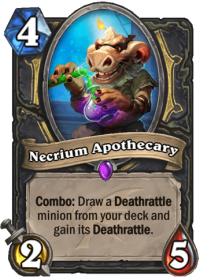
Like most good Hearthstone decks, the general principle of Deathrattle Rogue focuses on cheating large numbers of stats onto the board as quickly as possible (read: getting more stats than you should for the amount of mana you spend on them). This is predominately achieved through Necrium Apothecary which allows you to draw a Deathrattle minion from your deck while also gaining its Deathrattle as early as turn 3.
Since some Deathrattles are worth more than that much mana alone – never mind the 2/5 body that comes with the Apothecary – the card allows you to do something unfair, and unfair things win games. Your goal is to make the Apothecary do something as unfair as you can, as often as you can. This means heavily restricting the number of Deathrattle minions in your deck so as to guarantee that you get the best outcome every time.
The second main piece of synergy within these decks is Necrium Blade. This weapon allows you to activate the Deathrattle of a minion on your board without it dying. Now you can double-dip that unfairness, quickly generating two or more Deathrattle effects that should be worth a lot more mana than you’re paying for them.
In sum, the decks are good because they spend a lot less than they should for a ton of tempo.
How Can I Build The Deck?
There are currently two builds of this deck: one using Anubisath Warbringer and it’s older, less-popular, yet more-powerful brother, that uses Mechanical Whelps. While both decks are almost as powerful as each other, the Whelp version holds a win rate lead of approximately one-half to a full percent last time we had sufficient data to look at. This is particularly ironic, given that the Warbringer version has been generating some calls for nerfs to Necrium Apothecary, while the Whelp version flies relatively under the radar.
Let’s look at each to understand them better.
Warbringer Deathrattle
This version of the deck plays two copies of Anubisath Warbringer as its only Deathrattles. When activated, it will give all minions in your hand +3/+3. Because of this, you want a very minion-heavy deck (to maximize your buffs), and many cheap minions with immediate impact to quickly get your stats onto the board after the buff hits.
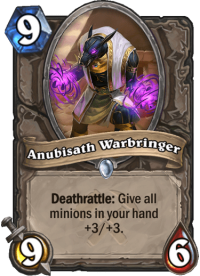
- The guide for playing this deck is generally simple: hard mulligan for Apothecary and nothing but that card if you don’t have it. Your deck just doesn’t function without it and becomes incredibly strong with it (hence around a 70% mulligan win rate). If you happen to have it already, feel free to keep a Necrium Blade and cheap minions/combo activators as well. The one exception to this rule is that you can think about keeping Anka, the Buried and Warbringer together if both are in the opening hand, though this will make your deck a little slower, so be mindful of your matchup.
- Against aggressive decks, if you have an Apothecary, feel free to keep minions with Lifesteal and Rush (such as Vicious Scalehide), as you’ll need them to come back onto the board and recover your life total. Don’t be afraid to commit minions to board early to keep your life total high.
- Against slower decks, if you have an Apothecary, just try to keep your hand as minion-heavy as possible until you play it, then generate wave after wave of large minions.
What to like about the Warbringer version: you have big, flashy turns and higher high rolls. This deck can make a lot of non-games happen. Indeed, this is where the calls for Apothecary nerfs largely come from: it can make many games that are legitimate blow outs where the opponent stands no chance. For many players, it awakens the old Quest Rogue vibes.
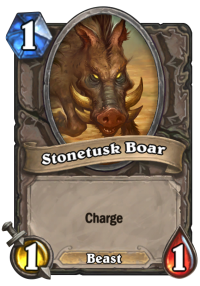
Another part of the deck to like is that it generates a lot of burst damage. Even if you’re behind on the board, that can very quickly be swung by buffed up Rushing, Lifestealing minions, or made irrelevant by killing your opponent with large sums of charge damage.
However, there are some things about the deck to not like either: first, it is a high-roll deck, meaning when you miss your powerful cards, you may feel unable to play the game effectively and just get run over. If high-rolling isn’t your thing, this deck may feel a little boring because of how one-dimensional it can be. Also, if you draw both Warbringers before you combo an Apothecary, you feel really bad.
The second reason to not like the deck is that it’s easier for your opponents to counter you. As so much of the Warbringer list relies upon drawing Apothecary, keeping Necrium Blade in the mulligan alone is a large risk. However, if you don’t have a blade it’s very easy for your opponents to either (a) silence/bounce/transform your Apothecary before it dies or (b) ignore the Apothecary and hit you in the face until you die. The first issue makes this deck not only more targetable by your opponents (and they will target you because of the negative play experience the deck can create), but also less fun to play by you because when your opponents target you effectively you don’t get to do the big, flashy things you want to.
Pros: Big, flashy swings and some easy wins. Can generate a lot of burst damage.
Cons: Bad draws can cripple the deck. Aggro gets under this list quite easily and it can be teched against effectively (teching is when you include cards in a deck that you usually wouldn’t play specifically to stop an opponent’s game plan).
Mechanical Whelp Deathrattle
This version of the deck plays two copies of Mechanical Whelp as its only Deathrattles. When activated, it will create a 7/7 mech dragon on the board immediately.
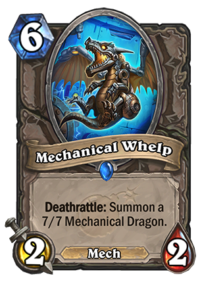
- Your mulligan here is a bit more complex. Generally you want to keep Necrium Apothecary and Blade. This will be your primary mulligan for any midrange or slower deck as it’s the strongest thing the deck does.
- When you have a hand that builds heavily towards a Galakrond start – like many of the invoke cards – you may also think about keeping that option as well, since the deck does both things as well as it can.
- The more aggressive your opponent, the more you keep early-game cards like Pharaoh Cat, Backstab, and Flybooter to fight for board and worry about the midgame when it arrives. Keeping Zilliax is a good move as well (as it will end the game against aggro if it lands on a 7/7), and Edwin can be a powerful play on the Coin.
What to like about the Whelp version: it’s the more stable of the two lists. You don’t need to play a bunch of bad, cheap minions in your deck that become good when buffed and can instead just play cards that independently better. Your high rolls aren’t as high, but your most common outcome is better. Your Whelps are castable cards at times they might impact a game, unlike Warbringers. This allows you to do things like keep Necrium Blade in the mulligan more of the time, or beat a silence/transform effect on your first Apothecary.
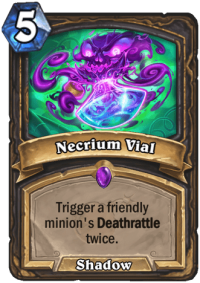
Similarly, this deck allows you to play Necrium Vial much effectively. As your opponent doesn’t want to trigger your Apothecary’s Deathrattle immediately and give you a 7/7, you can punish their lack of killing it by getting 14/14 total stats instead.
Vial works better in the Whelp list for a number of reasons. First, it’s a spell and not a minion. Since Warbringers only buff minions in hand, Vial is a liability there. Second, as we mentioned, Whelp is a playable minion and it doesn’t need Apothecary is be effective (unlike Warbringer). This means Vial is a dead card in the hand a lot less often in the Whelp version. Finally, Vial generates more immediate stats on the board in the Whelp list, allowing for potentially quicker pushes for lethal.
These issues are reflected by the Vial’s drawn win rate in each deck: whereas it’s an above-average card in the Whelp lists, it’s near the bottom of the Warbringer ones.
Another reason the Whelp list may outperform the Warbringer list is that its boards are harder to remove. A board of minions buffed by Warbringer can be cleared easily by a Brawl, Equality combos, or many other tools. By contrast, Whelp Deathrattles will leave behind additional 7/7s even if the initial board gets cleared.
Pros: Consistency, greater resistance to board clears, greater resistance to tech cards
Cons: Less burst potential, still weak to aggressive decks.
Summary
While both decks are strong and can provide you with comparable levels of success, I personally favor the Whelp version. Though the Warbringer deck is more popular and generates a seemingly-worse player experiences on both sides of the game, its flashy plays may not correspond to being the better deck, and it’s easier to disrupt.
